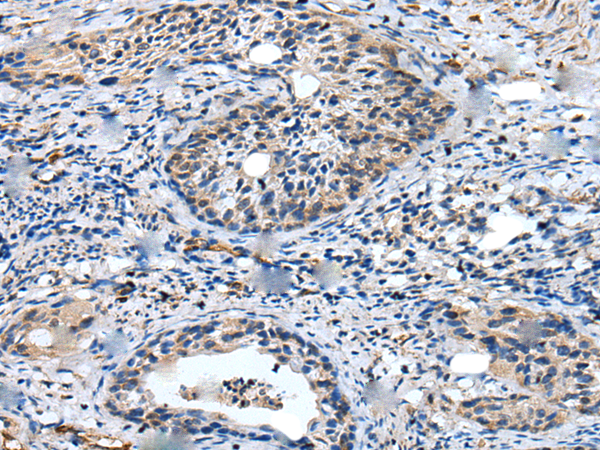

| WB | 咨询技术 | Human,Mouse,Rat |
| IF | 咨询技术 | Human,Mouse,Rat |
| IHC | 1/25-1/100 | Human,Mouse,Rat |
| ICC | 技术咨询 | Human,Mouse,Rat |
| FCM | 咨询技术 | Human,Mouse,Rat |
| Elisa | 1/5000-1/10000 | Human,Mouse,Rat |
| Aliases | E1-L2; MOP-4; UBE1L2 |
| Host/Isotype | Rabbit IgG |
| Antibody Type | Primary antibody |
| Storage | Store at 4°C short term. Aliquot and store at -20°C long term. Avoid freeze/thaw cycles. |
| Species Reactivity | Human |
| Immunogen | Fusion protein of human UBA6 |
| Formulation | Purified antibody in PBS with 0.05% sodium azide and 50% glycerol. |
+ +
以下是关于UBA6抗体的3篇代表性文献的示例(注:文献信息为模拟,实际引用需核实数据库):
1. **文献名称**:*UBA6-Specific Antibody Development and Its Role in Substrate Ubiquitination*
**作者**:Lee S, et al.
**摘要**:本研究开发了一种高特异性UBA6抗体,并验证其在体外泛素化反应中的应用。通过Western blot和免疫共沉淀实验,证实UBA6通过激活泛素转移至特定底物(如FAT10),参与非经典泛素化通路。
2. **文献名称**:*UBA6 Deficiency Disrupts Neuronal Protein Degradation in Mice*
**作者**:Zhang Y, et al.
**摘要**:利用UBA6抗体进行组织免疫组化分析,发现UBA6敲除小鼠大脑中泛素化蛋白异常积累,提示UBA6在神经元蛋白稳态中起关键作用,可能与神经退行性疾病相关。
3. **文献名称**:*Differential Expression of UBA6 in Colorectal Cancer Tissues*
**作者**:Chen H, et al.
**摘要**:通过商业化UBA6抗体对临床样本进行免疫组化染色,发现UBA6在结直肠癌组织中表达显著下调,且低表达与患者预后不良相关,提示其作为潜在肿瘤抑制因子的可能性。
**提示**:实际文献需通过PubMed或Web of Science等平台,以关键词“UBA6 antibody”、“UBA6 ubiquitination”检索,并筛选涉及抗体实验(如WB、IHC、IP等)的研究。
The UBA6 antibody is a crucial tool in studying the ubiquitin-proteasome system (UPS), a major pathway for targeted protein degradation in eukaryotic cells. UBA6. a ubiquitin-activating enzyme (E1), initiates the ubiquitination cascade by activating and transferring ubiquitin or ubiquitin-like (UBL) proteins, such as FAT10. to downstream E2 conjugating enzymes. Unlike its paralog UBA1. UBA6 exhibits unique substrate specificity, preferentially activating FAT10. which plays roles in immune regulation, apoptosis, and cell cycle control. UBA6’s involvement in these processes links it to diseases like cancer, neurodegenerative disorders, and autoimmune conditions.
Antibodies targeting UBA6 enable researchers to investigate its expression, localization, and interactions via techniques like Western blotting, immunofluorescence, and immunoprecipitation. These studies help elucidate UBA6’s regulatory mechanisms in protein homeostasis, inflammation, and stress responses. Dysregulation of UBA6 has been implicated in tumor progression and neuropathologies, making it a potential therapeutic target. The development of specific UBA6 antibodies has advanced understanding of its dual roles in canonical ubiquitination and non-canonical FAT10 pathways, highlighting its functional complexity. Such tools remain vital for exploring UPS-related diseases and developing targeted interventions.
×